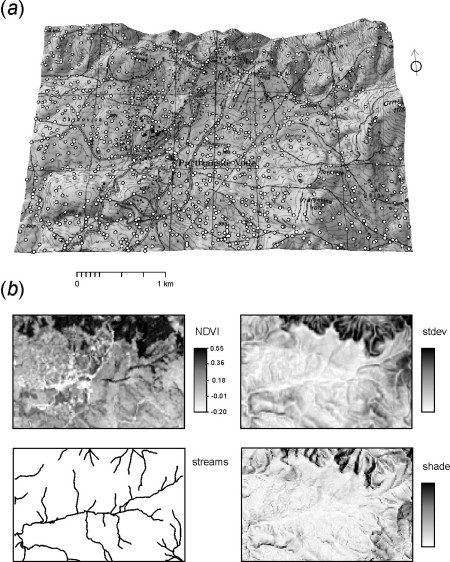Published: Aug 19, 2009 by Tom Hengl
The case study area ‘Zlatibor’ is located in the South-western part of Serbia (centred at 43°43’44.6’‘N and 19°42’37.8’‘E). The area is mainly hilly plateau, with the exception of the north-east part where the slopes are much steeper. Elevations range from 850 m to a maximum of 1174 m; the total size of the area is 13.5 square kilometers.
Study area Zlatibor: (a) perspective view on the area (1:25,000 topo-map) and location of 1020 error assessment points, (b) a preview of the auxiliary predictors used for the geostatistical modeling

Available layers:
- elevations.txt - a set of 2051 height measurements used for generation of DEMs;
- control.txt - a set of 1020 very precise spot heights used for error assessment;
- dem30.asc - the original topo-map DEM at 30 m resolution;
- SRTMDEM.asc - 3 arcsec (90 m) SRTM DEM;
Grid definition:
ncols: 150
nrows: 100
xllcorner: 7394249
yllcorner: 4841999
cellsize: 30 m
proj4:+proj=tmerc +lat_0=0 +lon_0=21 +k=0.9999 +x_0=7500000 +y_0=0 +ellps=bessel +towgs84=574.027,170.175,401.545,4.88786,-0.66524,-13.24673,0.99999311067 +units=m
Lineage:
The original topo-map DEM was produced by digitizing contour layers from two adjacent sheets of the 1:5000 topographic maps with contour interval of 5 m. Two sheets were scanned by ANATech Evolution scanner with 400 DPI resolution, then georeferenced to the Gauss-Krüger coordinate system (7th zone) and converted to a point map using a semi-automated digitalization of contour lines (I/GEOVEC, Intergraph program module). The faults obtained during automated digitalization were removed by 3D editing of contour lines. The final DEM was produced using the ArcGIS 3D analyst: first a TIN was produced, which was then converted to a regular grid of 30~m resolution. This will be referred to as the topo-DEM in further text. The original points extracted from the topo-map (51,847 points) were sub-sampled (for computational efficiency) to 2051 points.
A set of 1020 photogrammetric control points was provided with the help of the Geodetic governmental authority of Serbia. These were obtained throughout the orthophoto map production of the scale 1:1000 for local municipality. Aerial images were obtained using the RMK 21/23 analog camera with calibrated focal length f=207.96 mm. The average flying altitude was 1040 m. A stereoscopic model was produced using the WILD A10 analog stereo-restitution instrument and MapSoft2000 program package. The land-surface points were measured manually from the stereoscopic model with average lag of 15 m. This gave a total number of 46,021 points that were sub-sampled to 1020 points for faster processing. The estimated height accuracy of control points is 15 cm which allows us to use it as ground truth for the topo-DEM.
Data owner: Geodetic governmental authority of Serbia
Reference: Geostatistical modelling of topography using auxiliary maps
Location: Zlatibor, Serbia
43° 43’ 0.0012” N,19° 41’ 60” E
See map: Google Maps
Attachment:
